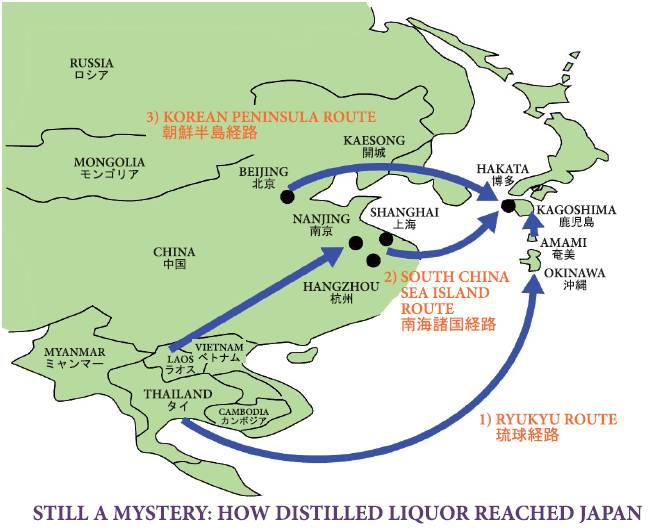Discovering Shochu: Episode 1 – History of Shochu Pt. 1
Origin of the Distillation Technology
Research shows that distillation machines existed in Mesopotamia near present day Iraq, around 3000 BC. Westward in Europe, distillation machines developed alchemy, and eastward, in India, provided the modern technique to produce medicines and perfumes. Much later around the 13th century during the Yuan Dynasty in China, distillation machines finally became a tool for producing alcoholic beverages. Some believe this practice originated in Yunnan Province, located just to the north of Myanmar.
Examples of distilled spirits which developed in Asia are China’s Rujiu (present day “Baijiu”) distilled from grains in the 13th century, and Thailand’s Lao-u (present-day Sato) from rice around the 14th century. In the 15th century, Okinawa’s Awamori which uses Thai rice as its ingredient, became the first distilled liquor to reach Japanese territory. And by the 16th century, Shochu production spread throughout Kyushu, using various grains. The earliest written mention of distilled spirits in Ryukyu Kingdom of the present day Okinawa, can be found in the Annals of the Joseon Dynasty compiled in Korea in 1477.
In the Western world, it’s said that vodka was the first, developed in Russia around the 14th century. By the end of the 15th century, distillation technology traveled from Ireland to Scotland by way of Christian missionaries, leading to the birth of the now famous Scotch whisky. French brandy is believed to have been developed in the 17th century.
Westerners originally referred to distilled spirits as aqua vitae in Latin, or “water of life”. In the Middle East, it is called arak, which comes from araq in Arabic meaning “droplets of sweat or condensation”, and arrack in Southeast Asia, both made with the two-vessel constructed, alembic distillation machine. During the Edo Period in Japan (1603 – 1868), Shochu was called arakishu which is probably derived from “arak” in the Middle East. And, it’s not simply a coincidence that China’s Rujiu “dew of sake” and Arabic arak “droplets of sweat”, both carry the same definition.
Distillation machines first reached the U.S. via the western route from Mesopotamia through the West Indies by the Europeans, brought to Kentucky, then onto Canada. Toward Japan, it traveled from Mesopotamia, through Southeast Asia.
Eastern Distilled Spirits: Burned Spirits
Japan: Shochu
Old Name: Arakishu
Korea:Soju
Old Name: Arak-ju
China: Shaojiu
Old Name: Rujiu
Western Distilled Spirits “Aqua Vitae”
Whisky
Gallic: uisge beatha (Etymology)
Vodka
Russian: zhiznennia voda (Etymology)
Brandy
French: eau de vie (Etymology)
German: brandewijn which means “burnt wine” (Etymology)
Questions on How Distilled Liquors Reached Japan
How exactly distillation arrived from Southeast Asian and into Japan remains a subject of much debate, and scholars are continuing their research. What they are sure of is that spirits similar to Shochu were available in both China and in Southeast Asia between the 13th to 14th centuries. There are three possible theories on how exactly the distillation technique reached Japan:
1. The Ryukyu Route:
Ryukyu Kingdom of the present day Okinawa, was a major maritime trade post for Japan, China, Korea and Southeast Asian countries around 14th century, where various types of distilled spirits were being imported.
2. The South China Sea Islands Route:
Wakou or the Japanese armed merchant pirates expanded their trading areas to the Korean peninsula, China and to Southeast Asia around 14th to 15th centuries, and introduced distilled spirit to Japan as one of their maritime traded goods.
3. The Korean Peninsula Route:
By the 15th century, Japan was in a trade relationship with Ryukyu Kingdom, the islands in the South China Sea, Korea, and countries in Southeast Asia. It is safe to assume that their trading goods included alcoholic beverages. Ko-raishu or “Korean alcoholic beverage” was introduced to Japan via Tsushima island of Nagasaki.
According to scientific investigations conducted by historians, the Ryukyu route merits the highest credibility for the following reasons:
1) There is a great similarity between the Lao-u product of Thailand and the Awamori of Okinawa.
2) The mash pot and distillation machine used to produce Lao-u are very similar to Ranbiki, an ancient distillation machine used in producing Awamori.
3) The Annals of Joseon Dynasty written in 1477 mention the distilled beverage being produced in Ryukyu Kingdom.
4) Ryukyu Kingdom was in an active, direct trade relationship with Siam (present day Thailand) around 14th century. It is natural to assume that this distillation method was transferred from Ryukyu Kingdom to the Amami Oshima Islands of Kagoshima Prefecture further up north.
————
WHAT IS SHOCHU?
Shochu, pronounced “show-chew”, is a colorless, Japanese spirit made from high starch grains and vegetables such as rice, millet, barley, buckwheat, molasses, corn and sweet potatoes. When scripted in Chinese characters, its literal translation is “burned spirit”, which indicates SHOCHU’S high level of potency as an alcohol beverage.
SHOCHU is a distilled spirit. SHOCHU is to Sake, what Chinese Maotai is to Laochu, and what brandy is to wine.



Comments
jamieson
thank you so much for this! what a fantastic series. so hard to find shochu information in english!! sending all our friends here.